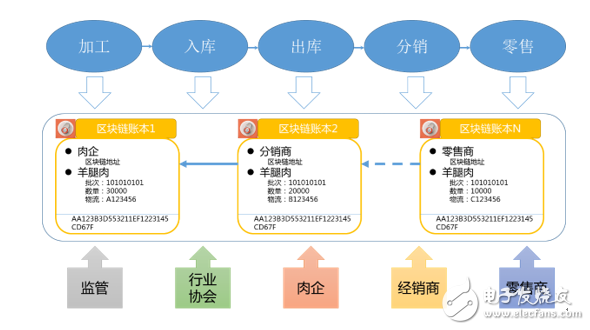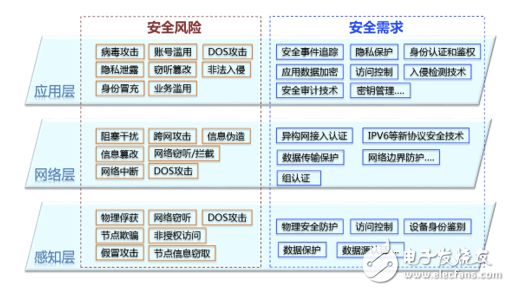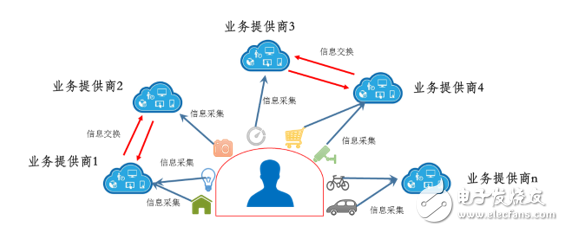As one of the current domestic and international focus technologies, blockchain technology may have an important impact on future technological innovation and industrial transformation, and there will be broad development space in the Internet of Things. This paper introduces the basic situation of blockchain technology development, discusses the main direction of blockchain technology application in the Internet of Things, and analyzes the challenges faced by blockchain technology in IoT applications.
As a model for the high integration and comprehensive application of the new generation of information and communication technologies, the Internet of Things is deeply integrated with the economy and society, and profoundly changes production activities, social management, and public services. With the popularization and deepening of Internet of Things technology in various industries, human society is entering a new era of “Internet of Everythingâ€, and tens of billions of new devices such as wearable devices, smart home appliances, self-driving cars, and intelligent robots will be connected. Entering the network has also made the Internet of Things one of the most active and widely used areas of global technology innovation. Cloud computing, big data, next-generation mobile communication technology and intelligent sensing, industry applications are intertwined, stirring and merging, constantly inspiring innovation and becoming a new impetus for the development of the Internet of Things. As one of the current domestic and international focus technologies, blockchain technology may have an important impact on future technological innovation and industrial transformation. How to locate and apply blockchain technology in the Internet of Things is worthy of further consideration and discussion.
Blockchain technology and applicationThe concept of blockchain was first proposed at the end of 2008 by a paper published by the pseudonym Satoshi Nakamoto in the Bitcoin Forum. The blockchain technology in the thesis is the basic technology for constructing bitcoin data structure and transaction information encryption transmission. This technology realizes the mining and trading of bitcoin.
Blockchain is an integrated application of distributed digital storage, point-to-point transmission, consensus mechanisms, and encryption algorithms. In a narrow sense, a blockchain is a chained data structure in which data blocks are sequentially connected in a chronological order, and cryptographically guaranteed non-tamperable and unforgeable distributed ledgers. Broadly speaking, blockchain technology uses blockchain data structures to validate and store data, use distributed node consensus algorithms to generate and update data, use cryptography to ensure data transmission and access security, and utilize intelligent contracts. A new distributed infrastructure and computing paradigm for programming and manipulating data. Compared with the traditional database technology, the blockchain has three characteristics: one is the unchangeable modification of the data; the second is the collective maintenance of the system; the third is the openness and transparency of the information. At the same time, compared with the traditional database technology, the blockchain technology at this stage has small data throughput and large read/write delay, which is more suitable for reliable storage and processing of low frequency and small data.
From the technical application of the existing blockchain, the blockchain infrastructure generally consists of a combination of data layer, network layer, consensus layer, incentive layer, contract layer and application layer. The data layer encapsulates the underlying data block and related data encryption and time stamping technologies; the network layer includes a distributed networking mechanism, a data propagation mechanism, and a data verification mechanism; and the consensus layer mainly encapsulates various consensus algorithms of the network nodes. The incentive layer integrates economic factors into the blockchain technology system, including the issuance mechanism and distribution mechanism of economic incentives; the contract layer mainly encapsulates various scripts, algorithms and smart contracts, and is the basis of the programmable features of the blockchain; The application layer encapsulates the various applications of the blockchain. In this model, time-stamp-based chain block structure, distributed node consensus mechanism, and flexible programmable smart contract are the most innovative technical links of blockchain technology.
The global blockchain application exploration is very active, and overall it is still in a small-scale proof of concept phase. The current application of blockchain technology is mainly concentrated in two aspects: First, the direct exchange of data is realized in the absence of mutual trust and lack of intermediary between different institutions or individuals. Blockchain technology is derived from Bitcoin and is the underlying data storage technology for Bitcoin, so finance is the hottest area for blockchain applications. Ripple has introduced blockchain technology to provide cross-border transfer, clearing and payment services to a number of banks as early as 2012. Compared with traditional channels such as SWIFT (Global Interbank Financial Telecommunications Association), it can save 1/3. Fees, compressing operations such as cross-bank reconciliation from a few days to a few seconds. The application of blockchain in financial scenarios such as digital currency, payment settlement, securities trading, and mutual insurance is also highly valued. In addition, in the energy sector, US companies such as Brooklyn MicroGrid use blockchain technology, and smart grid users can exchange power resources without the need for a power company. In the medical field, Swiss company HealthBank and US company Gem use blockchain technology to store medical data, helping many hospitals and medical institutions to directly exchange electronic medical records.
The second is for the preservation and reliable storage of important data. Utilizing the characteristics of the blockchain that cannot be tampered with, the preservation of important data (such as legal documents such as ownership, agreements, and bills) has become a hot spot for application exploration. At present, the governments of Estonia, Georgia and other countries are trying to use the blockchain technology to register important assets and carry out the registration of important information such as land registration, business registration and electronic taxation. Pryor Cashman, a US legal services company, launched Monograph, a trading platform for digital products such as music and video, using blockchain technology to solve the problem of ownership and certification of digital art. The domestic website “Preservation Network†authenticates the authenticity of the electronic information such as the identity information, operation records of the Internet financial platform and insurance certificates in the insurance business through blockchain technology, and interfaces with the notary office and the judicial identification center to provide notarization. Books, judicial identification reports and other services.
Discussion on the Application of Blockchain Technology in Internet of ThingsIt should be said that the core value of the blockchain is to establish an open and transparent rule through program algorithms, based on which to create a trust network, to ensure peer-to-peer trust and transaction security, which abandons the traditional The centralized third-party organization also eliminates the need for unified account book update and verification. With the continuous expansion of the scale of the Internet of Things, building a “giant system†of tens of billions of devices, the Internet of Things faces a series of challenges such as security privacy protection, data authenticity guarantee, system scalability and information sharing, and application blockchain. The space for technology is very broad. In general, the application of blockchain technology in the Internet of Things is mainly in the following three aspects.
The core concept of the Internet of Things is to transform the hidden data of the physical world into explicit data through sensing devices such as sensors, and then obtain the operational rules and related knowledge of the objective world from explicit data. As the projection of the physical world in the network information space, the Internet of Things has higher requirements for the authenticity of data in the process of generation, transmission and processing. This is also one of the main directions that blockchain technology may be applied in the Internet of Things. It has broad application space in the fields of product traceability and car networking.
Take product traceability as an example. Product traceability is one of the important application fields of Internet of Things technology. It is widely used in the traceability of the origin of agricultural and livestock products, the traceability of raw materials and spare parts for industrial production, and the anti-counterfeiting of consumer products. The main implementation method is to assign a unique identifier (which can be an RFID radio frequency label, a two-dimensional code, and the like) for the traceable product, and associate relevant information of the product (such as origin information, manufacturing enterprise information, etc.) in the identification, and purchase the The enterprise or consumer of the product can read the information in the identification through the identification and identification device (such as RFID reader/writer, mobile phone QR code scanning, etc.), and realize the functions of traceability and authenticity inquiry of product information. The application of blockchain technology in the process of product traceability can form a traceability chain of multi-participation and information transparency, sharing and fidelity. Establish blockchain books in the production, processing, sales and other aspects of the product, and establish a full chain path of genuine traceability to the end user or consumer. The traceability chain structure established by taking meat products as an example is shown in Figure 1.

Figure 1 Traceability structure of meat products
The traceability chain constructed by blockchain technology has the characteristics of open and transparent data, unforgeable, non-tamperable and irrevocable, and can solve the problem of authenticity of product data technically. In this traceability chain, whether it is a production enterprise, a distributor, a retailer, or a regulatory authority, it is able to share data of each link based on the traceability chain, effectively solving the current data traceability of the product may be encountered at a certain link. Tampering caused the overall data distortion problem. In addition, in the V2X interaction process of the Internet of Vehicles, in order to ensure the reliability of the road information between the high immediacy and the high uncertainty in the vehicle, to avoid the failure of the data information, the blockchain technology can also be used to construct the “road conditionâ€. "chain" to ensure the transparent and reliable transmission of information.
Blockchain technology enhances the security of IoT systemsWith the advent of the era of Internet of Everything, the security threat of the Internet of Things has become increasingly prominent. The Internet of Things nodes are widely distributed; the number is large, the application environment is complex, and the computing and storage capabilities are limited, which makes the security of the Internet of Things relatively fragile. With the application of the Internet of Things in the national strategic basic industries such as industry, energy, electricity, transportation, etc., once security problems occur, it will cause incalculable losses. From the Iranian earthquake-net virus attack on nuclear facilities, the Ukrainian power grid was affected by Trojans at the end of 2015 and the local power outages to the event that the Internet of Things terminals in the United States were attacked by Trojans in 2016, the Internet was rampant, and the Internet of Things security problem became increasingly prominent. Related to security, there is data privacy protection for the Internet of Things. With the development of the Internet of Things platform, how to ensure the data privacy in the Internet of Things is also an urgent problem for industry users. Regardless of security or privacy protection, the application of Internet of Things is still a common security protection technology and means in the Internet or communication network. This kind of "grafting" is not sufficient for the specific requirements of the Internet of Things itself in terms of security and data privacy protection, and it is difficult to cope with the scalability problems caused by the substantial increase in the number of IoT devices. The security risks and security requirements of the Internet of Things are shown in Figure 2.

Figure 2 Security risks and security requirements of the Internet of Things
The application of blockchain technology can enhance the security of the Internet of Things to a certain extent, and currently plays an important role in the following aspects.
First, the identification of the legal identity of the Internet of Things node. Due to the limited computing and storage capabilities of the IoT-aware device, it is difficult to apply security measures with high complexity and high performance requirements on the sensing device, and the risk of counterfeiting is high. The blockchain verification and consensus mechanism helps identify legitimate IoT nodes and avoids the access of illegal or malicious IoT nodes or devices.
Second, the privacy protection of Internet of Things data. The centralized IoT solution is used by the platform to aggregate and process the perceived data. For industry users accessing the IoT platform, the IoT platform is faced with storing and forwarding IoT data related to user privacy in an unlicensed manner. The distributed, uncentralized structure brought by the blockchain and the way of encrypting all transmitted data will effectively solve this problem.
Third, the security of the Internet of Things network infrastructure. Whether it is an Internet of Things application built on the Internet or an Internet of Things private network, centralized service delivery devices in its network infrastructure are the focus of security attacks. For example, using DDOS to attack an Internet DNS server, or DDOS attacking a base station or a core router, etc., will cause network paralysis. The use of blockchain technology to transform centralized services into distributed services can effectively prevent attacks on critical core network infrastructure.
Blockchain technology changes the information exchange mode of the Internet of Things
The development of the Internet of Things will bring tens of billions of devices, and these devices will be divided into different platforms to form a centralized device connection structure. The status information of users obtained by different devices is one-sided, but due to different service providers and different platforms, direct information exchange or transactions cannot be performed between devices. In the existing IoT information interaction model, the information exchange between devices needs to be performed through the platform to which the device belongs (of course, the premise of information exchange is that the service providers of the devices have reached agreement), and this information exchange mode is not only efficient. Low, and requires agreement between service providers, and requires inter-platform interoperability technology support. The existing information exchange mode of the Internet of Things is shown in Figure 3.

Figure 3 Existing information exchange model of the Internet of Things
The use of blockchain technology in the deployment of IoT equipment vendors can quickly and effectively establish mutual trust and transaction networks between devices, and promote the exchange of IoT information exchange modes from platforms to peers. The way of exchange or trading changes. Decentralized data flow will be able to quickly and accurately correlate relevant information. Fragmented information will form systematic information that can more accurately reflect the operational state of the objective world, promote business and application innovation, and serve the Internet of Things. Development opens up new spaces.
The challenge of blockchain technology in the application of the Internet of ThingsAlthough the blockchain technology has a wide application scenario in the Internet of Things, it should also be seen that the blockchain technology is still in the early stage of development. The main application scenarios are mainly finance and accounting, and its technological advancement is Gradually expand to other areas. Therefore, in the process of blockchain expansion to the Internet of Things, the challenges should be considered, including but not limited to the following three points.
First, the deployment and implementation of blockchain technology requires the participation of multiple nodes, but now the storage and computing capabilities of IoT node devices are generally limited, and the networking capabilities are also weak. Therefore, how to deploy blockchain technology in IoT nodes, whether to adopt a hierarchical blockchain architecture in the Internet of Things, and what needs to be done in the existing blockchain technology are all issues to be considered;
Second, many Internet of Things applications have higher requirements for real-time, such as car networking services. However, the existing blockchain consensus mechanism generally has a large delay (especially as the node size increases, the delay may further increase). Consensus delay may cause feedback delay and alarm delay, which cannot meet the needs of existing IoT applications, and needs to be further improved in technology;
Third, the application of the blockchain in the Internet is only carried out within a certain range and limited nodes. Once the blockchain is applied in the Internet of Things, the number of nodes will increase geometrically, and its frequent relational data query requests will pose a very serious challenge to the existing chained data architecture.
In the current era, a new round of global technological revolution and industrial transformation is emerging. Network information technology has turned into productivity at an unprecedented speed and has profoundly changed the global landscape. The Internet of Things has broad prospects for development and faces rare historical opportunities as well as many challenges. The application of blockchain technology in the Internet of Things can solve the problems faced by the Internet of Things to a certain extent. At the same time, the new requirements put forward by the Internet of Things will also inject new vitality into the development of blockchain technology.
Suizhou simi intelligent technology development co., LTD , https://www.msmvape.com